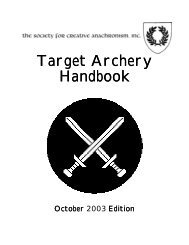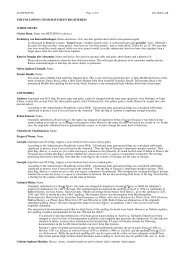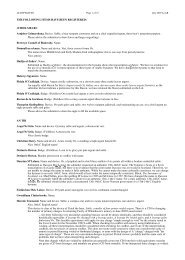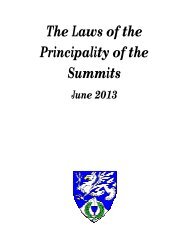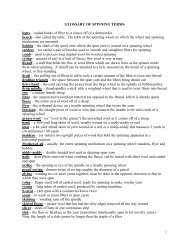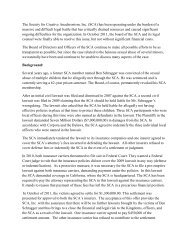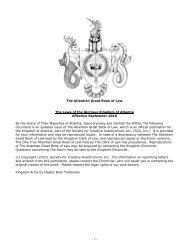The Standards for Evaluation of Names and Armory - SCA Heraldry
The Standards for Evaluation of Names and Armory - SCA Heraldry
The Standards for Evaluation of Names and Armory - SCA Heraldry
Create successful ePaper yourself
Turn your PDF publications into a flip-book with our unique Google optimized e-Paper software.
<strong>The</strong> <strong>St<strong>and</strong>ards</strong> <strong>for</strong> <strong>Evaluation</strong> <strong>of</strong> <strong>Names</strong> <strong>and</strong> <strong>Armory</strong>:<strong>The</strong> Rules <strong>for</strong> SubmissionsNotes: Old English: Patronymics take <strong>for</strong>m <strong>of</strong> X sunu/sune or Xdohtor (X is father's name in genitive); they must match the given name's gender. Alternately, they mayfollow the Latinized patterns. Locatives use æt or <strong>of</strong> followed by the placename in dative <strong>for</strong>m. See the introduction to Reaney <strong>and</strong> Wilson A Dictionary <strong>of</strong> EnglishSurnames <strong>for</strong> more details.Middle/Early Modern English: Marked patronymics may use Fitz X or Xson; women may use these or use Xdaughter. <strong>The</strong>se <strong>for</strong>ms may all use the father's nameunmodified; Xson <strong>and</strong> Xdaughter may also use the possessive <strong>for</strong>m. Alternately, they may follow the Latinized patterns. Late period family names tend to drop articles<strong>and</strong> prepositions. See the introduction to Reaney <strong>and</strong> Wilson A Dictionary <strong>of</strong> English Surnames <strong>for</strong> more details.Anglicized Irish: See Mari ingen Briain meic Donnchada, "<strong>Names</strong> Found in Anglicized Irish Documents"( http://medievalscotl<strong>and</strong>.org/kmo/AnglicizedIrish/) <strong>for</strong> details <strong>of</strong>how patronymic bynames are marked.Welsh: See Tangwystyl verch Morgant Glasvryn "A Simple Guide to Constructing 13th Century Welsh <strong>Names</strong>" (http://heraldry.sca.org/laurel/welsh13.html) <strong>and</strong> "ASimple Guide to Constructing 16th Century Welsh <strong>Names</strong>" (http://heraldry.sca.org/laurel/welsh16.html) <strong>for</strong> more details.Scots: See Black Surnames <strong>of</strong> Scotl<strong>and</strong> <strong>for</strong> more details.FrenchDoubleGiven<strong>Names</strong>FrankishFrench Late Phrase (seenotes),unmarked, orinn sign nameOccitan/ProvençalLateLocative Patronymic OtherrelationshipPhrase (seenotes),unmarkedMarked,unmarkedare morecommonMarked,unmarkedNotes: All patterns in Frankish must be documented.widow, otherwidow, otherDescriptive/OccupationalYes; may usearticle le, la, l',les or un/une oromit itYes; may usearticle le, la, li,l', les or un/uneor omit itDictus Double Bynames OrderYes; usuallycombiningsurnamesusing ditYes; usuallycombiningsurnamesusing aliasYes; secondbyname is usuallylocative; doublesurnames are rareYes; but rare <strong>for</strong>men; second nameusually locativegiven+bygiven+byname+locativegiven+byname dit bynamegiven+bynamegiven+byname+locativegiven+byname aliasbynameAcute accents may be written or omitted, as long as they are used consistently. Other diacritics must be documented to be used, as they were rare in period. Capitalizationpatterns are inconsistent, but combinations <strong>of</strong> lower <strong>and</strong> uppercase elements must be documented.French: Locatives may be derived from place names, in the <strong>for</strong>m de X (or d'X, if X starts with a vowel); from generic toponyms, with du X, de la X, or des X; or fromsigns, with au Z, à la Z, or aus/aux Z.Occitan: Marked locatives look like those from French; inn sign names have not been found in Occitan to date.Rules <strong>for</strong> Submissions - January, 2012



